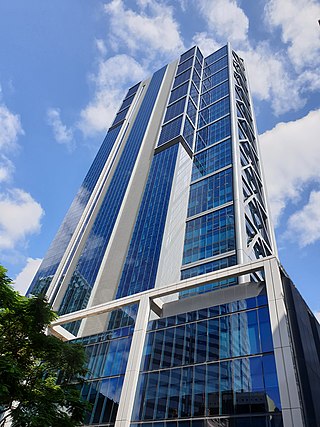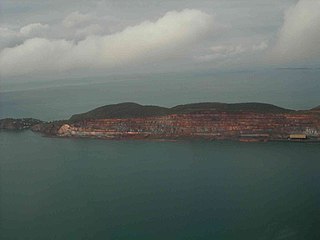
BHP Group Limited is an Australian multinational mining, metals, natural gas petroleum public company that is headquartered in Melbourne, Victoria, Australia.

Whyalla was founded as "Hummocks Hill", and was known by that name until 1916. It is the fourth most populous city in the Australian state of South Australia after Adelaide, Mount Gambier and Gawler and along with Port Pirie and Port Augusta is one of the three towns to make up the Iron Triangle. As of June 2018, Whyalla had an urban population of 21,742, having declined at an average annual rate of -0.75% year-over-year over the preceding five years. It is a seaport located on the east coast of the Eyre Peninsula and is known as the "Steel City" due to its integrated steelworks and shipbuilding heritage. The port of Whyalla has been exporting iron ore since 1903.

The Eyre Peninsula is a triangular peninsula in South Australia. It is bounded by the Spencer Gulf on the east, the Great Australian Bight on the west, and the Gawler Ranges to the north.

Cockatoo Island is an island in the Buccaneer Archipelago off the coast of Western Australia near the town of Derby. It was mined for iron ore by the Broken Hill Proprietary Company from 1951 until 1984. Koolan Island is a neighbouring island that was also mined by BHP for high grade iron ore. It was most recently mined by Perth-based mining company, Pluton Resources until the company was placed under administration in September 2015.
Arrium was an Australian mining and materials company, employing nearly 10,000 workers, that went into voluntary administration in 2016 with debts of more than $2 billion. In 2017 it was acquired by British-owned Liberty House Group.
Guillaume Daniel Delprat CBE was a Dutch-Australian metallurgist, mining engineer, and businessman. He was a developer of the froth flotation process for separating minerals.

Port Bonython is the location of a deepwater port, gas fractionation plant and diesel storage facility west of Point Lowly in the Upper Spencer Gulf region of South Australia. It lies 16 km east-northeast of Whyalla, South Australia and approximately 370 km north-west of the State's capital city, Adelaide. The existing wharf is 2.4 kilometres long and is capable of berthing small Capesize ships with a maximum capacity of 110,000 tonnes. The wharf was established in 1982 and named after John Bonython, the founding chairman of Santos. The structure is leased to Santos by the Government of South Australia and is used for the export of hydrocarbon products. An oil spill at Port Bonython in 1992 resulted in loss of bird life and damage to mangrove habitats to the west and southwest of Port Pirie.
Iron Baron was a settlement associated with the Iron Baron iron ore mine on Eyre Peninsula at the southern edge of South Australia's Far North region, 413 kilometres north-west of Adelaide.

The Whyalla Steelworks is a fully integrated steelworks and the only manufacturer of rail in Australia. Iron ore is mined in the Middleback Range to feed the steelworks, resulting in the distribution of finished steel products of over 90 different grades. It occupies a 1,000 ha site on the shore of False Bay, Spencer Gulf and is the largest employer in Whyalla, South Australia.

HMAS Koolonga was a 4,260 gross register tons cargo ship built by Sunderland Shipbuilding Company, South Dock Sunderland, England, in 1914 and bought by McIlwraith, McEacharn Line Pty Ltd, Melbourne and named SS Koolonga. She was requisitioned by the Royal Australian Navy on 6 August 1914, as a collier and supply ship. She was returned to her owners in late 1915. She was sold in 1937 to Madrigal & Company, Philippines and renamed Paz. She was sunk during the Second World War at Manila Bay in December 1941 and was later salvaged by the Imperial Japanese and renamed Hatsu Maru. While at anchor in Manila Bay, Philippines on 13 November 1944, she was attacked by United States Navy carrier aircraft and was sunk.

Port Kembla is a man-made cargo port or artificial harbour, with an outer harbour protected by breakwaters and an inner harbour constructed by dredging, located in the Illawarra region of New South Wales, Australia.
The BHP Whyalla DE class are a class of diesel locomotives built by Clyde Engineering, Granville for BHP between 1956 and 1965.
The Middleback Range is a mountain range on the eastern side of Eyre Peninsula in South Australia. The Middleback Range has been a source of iron ore for over a century, particularly to feed the Whyalla Steelworks. Mines in the region were first developed by BHP from the 1890s and are now owned and operated by Liberty House Group.
SIMEC Group Ltd is a British international energy and natural resources business focused on resources, sustainable power, infrastructure, and commodities trading. In 2016 it had an annual turnover of almost USD2.5 billion and net assets of USD350 million. It is part of the Gupta Family Group ("GFG") Alliance, owned by members of the Gupta family, which had a combined turnover of more than USD13 billion and combined net assets of more than USD2.3 billion. Its activities span renewable energy generation, mining, shipping, and commodities trading.
Leslie Bradford was a mining engineer in Australia credited with several important inventions in the treatment of metal-bearing ores.
The BHP Whyalla Tramway is a 1067 mm gauge heavy-haul railway, 112 kilometres long, on the Eyre Peninsula in South Australia. It runs from haematite mines at Iron Monarch, Iron Baron and Iron Duke in the Middleback Range, about 50 kilometres west of Whyalla, to company steelworks at the coastal city of Whyalla. Opened in 1901, it was built by, and until 2000 operated by, the Broken Hill Proprietary Company (BHP). As of 2021 it was owned by Liberty House Group and operated on its behalf by rail operator One Rail Australia, which was sold in 2022 to Aurizon.
Fitzgerald Bay is a large bay located between Point Lowly and Backy Point in South Australia's upper Spencer Gulf. The bay's shoreline consists mostly of pebble beaches and sparse grey mangroves. In the 2000s the bay was used for the farming of yellowtail kingfish until their closure circa 2011 in response to high levels of fish mortality. Understanding of the environmental impacts of yellowtail kingfish farming is limited. As of 2021, fish farming has not returned to Fitzgerald Bay, but aquaculture zones remain in place, and Clean Seas is authorised to restock fish farms there. There are approximately forty shacks and coastal homes sparsely distributed along the fringe of Fitzgerald Bay whose interests are represented by the Cultana Jenkins Shackowners' Association.

Charles Henry Hoskins (1851-1926) was an Australian industrialist, who was significant in the development of the iron and steel industry in Australia.

Sir Cecil Harold Hoskins (1889–1971) was an Australian industrialist associated with the iron and steel industry. He is notable mainly for the establishment of the steel industry at Port Kembla, the company Australian Iron & Steel, and its subsequent merger with BHP in 1935. He was also on the board of the Australian Mutual Provident Society for many years and was its chairman from 1947 to 1962. He is less well known for his involvement in centre-right political organisations and the scouting movement, and his interest in landscape gardens.











